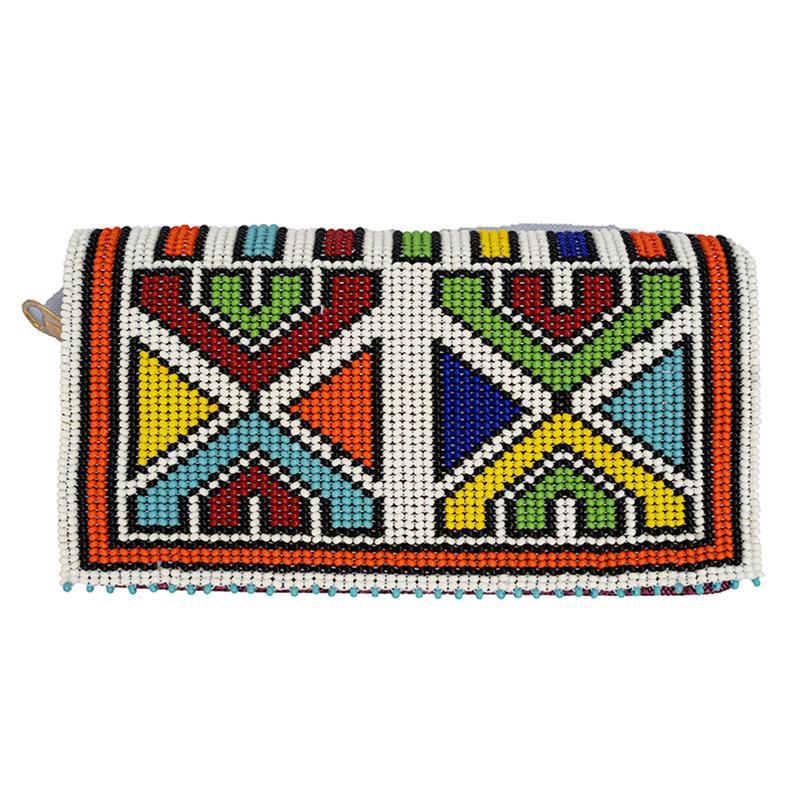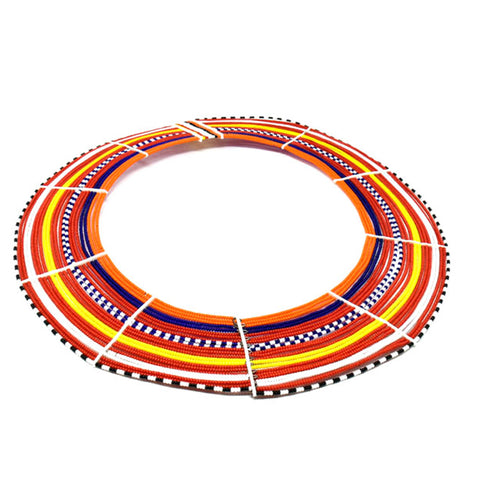
Get to Know More About the Master Beaders of Africa
The Story and History Behind Traditional Ndebele and Maasai Beaded Jewelry

The vibrant and beautiful Ndebele and Massai beadworks have an incredible history and meaning. The beadworks are used to create accessories like necklaces, bracelets, pendants, anklets, belts, sandals, home décor, and several household tools.

NDEBELE

The Ndebele people are Zulu-speaking people who live near the border of South Africa and Zimbabwe. They are one of the most colorful and distinctive tribes in Africa. Their bold geometric beadwork holds significant social and symbolic meaning.

Ndebele women cement their social and cultural identities through the language of beadwork. They are skilled artisans known worldwide for their use of glass beads. The elaborate and labor-intensive designs are made by hand. Traditional older pieces of Ndebele beadwork are distinguished by large areas of white beads interspersed with small geometric designs in color. Symmetrical abstract geometric designs identify contemporary beadwork, and later pieces include references to everyday life such as pitched-roof houses, license plates, electrical lights, and telephone poles.

In the past, the beads used were made from locally available materials such as shells, metals, animal bones, and hides. However, as trade with Europe began to increase throughout southern Africa, beads began to be made primarily of glass imported from India and China. In the 19th and 20th centuries, large quantities of glass beads were imported from Europe to make items unique to the region. Today, much of Ndebele beadwork is made of glass or plastic beads. However, the immense significance that beadwork has in the lives of women and the way that meaning is communicated through colors, geometric patterns, and the movement continues to still resonate through these new materials.

At Luangisa, we work directly with Zulu women artisans in South Africa to produce high-end beaded jewelry based on traditional beading techniques infused with modern aesthetics. Through our collection, we preserve the traditions of this unique tribe.
MAASAI
The Maasai people of Kenya are well known for their traditional handmade beaded jewelry – it is a vital aspect of Maasai culture. The practice is done primarily by women, and it’s considered their social duty to learn beadwork. These Maasai beadworks like colorful necklaces, bracelets, and pendants are for both men and women and are used in cultural traditions such as weddings, rituals, and community events.
The Maasai beaded jewelry represents beauty, strength, tradition, warriorhood, marriage, age sect, marital status, social status, and deep love and loyalty for their cattle.
The Maasai beaded jewelry has essential and specific cultural significance. Beauty is a crucial aspect of Maasai culture for women and men, and beads are used as adornment throughout everyday life and ceremonies.
For example, when women get married, a unique wedding collar is made for them by their mother. Traditional wedding collars have multiple beaded strands hanging off the collar, denoting the dowry in cows that will be given to the family of the bride. Even though this collar is reserved for the wedding day, women wear similarly layered collars in everyday life and ceremonies to signify wealth and beauty. Unmarried females wear massive flat beaded discs around their neck when dancing to symbolize grace and flexibility. Additionally, individuals of high social standing will wear more colorful and intricate jewelry.
The tradition of Maasai beadwork dates back hundreds of years. Before the arrival of Europeans to East Africa in the late 1800s, the Maasai women used clay, sticks, seeds, shells, dried grasses, and other natural materials to make beads. Theydyed some of these items to achieve a specific color. Over time, they began using attractive beads made of plastic and glass that they obtained from other communities through trade. The Maasai beadwork became significant and known to the rest of the world in the 19th century. Today glass is the primary material used by the tribe for their beads.

Today, beadworks serve as an essential source of income for the Maasai. For years the Maasai practiced pastoralism—livestock was their only source of income. They would depend on milk from their cows and goats and the trade of livestock to sustain their families needs. But hot and arid conditions affected the pasture land. Faced with drought and unproductive drylands, Maasai communities turned inward to women and looked to repurpose one of their most celebrated traditions—beadwork.

The colors used in the beadwork are chosen for their beauty. Each color bead symbolizes a different aspect of the Maasai culture. The colors are also symbolic and have essential meanings understood by the tribe. Often these meanings have an association with cattle, which is the Maasai’s primary food source and for which they have a deep connection.

There are several different colors used in Maasai beadwork, and each one holds a special meaning:
White: Represents purity and peace, symbolizing the color of cow’s milk that provides sustained nourishment.
Red: Denotes bravery, strength, unity, and the incredible challenges Maasai people face each day.
Orange: Symbolizes warmth, friendship, generosity, and hospitality. Orange represents the color of a gourd used to share milk with guests and welcome visitors into one’s home.
Blue: Denotes energy and sustenance and the color of the sky, which provides water for the people and their cattle
Yellow: Symbolizes health, fertility, and growth, denoting the color of the sun, which helps nourish the grass to feed the livestock and preserve life.
Green: Represents nourishment and production, symbolizing the land that provides food for the people and their livestock. Green also implies putting down roots and the protection of one’s territory.
Black: Denotes unity, harmony, and solidarity. It also symbolizes the color of the people and the daily struggles they endure each day.

At Luangisa, we directly work with Maasai women to produce and market high-end beaded jewelry based on traditional beading techniques infused with modern aesthetics.
Each piece tells a story. Beaded jewelry is part of the Maasai identity, and through our collection, we tell their stories and preserve the traditions of this unique tribe. Maasai culture is highly patriarchal, and it is the women who are hurt the most by issues of structural inequality. With us working directly with them, they are finally given the opportunity to progress both socially and economically.

Want to own a piece of the Ndebele and Maasai beadwork?
Discover a variety of beaded jewelry, accessories, and home decor made by Zulu and Maasai artisans here.



Comments
Leave a comment